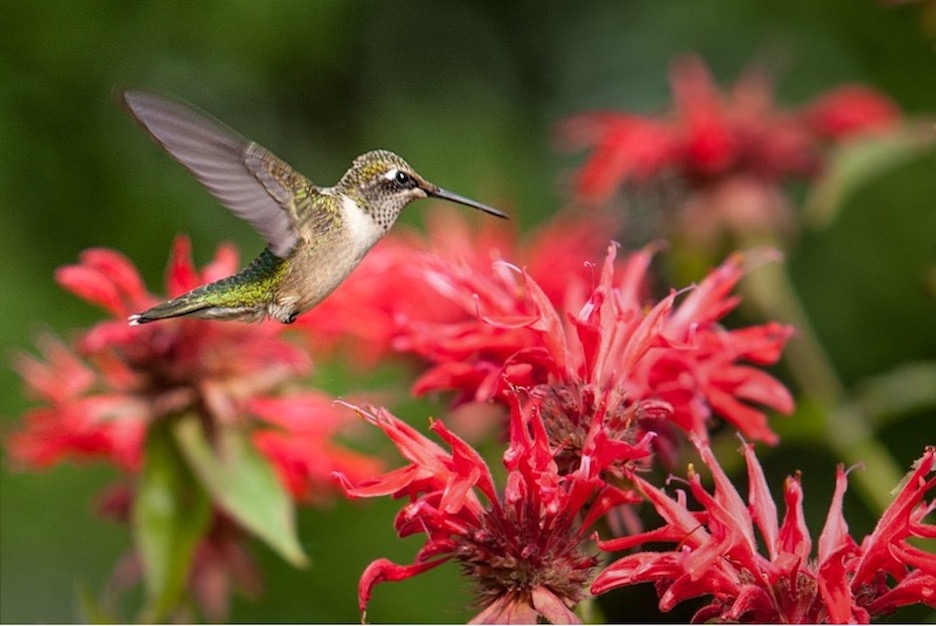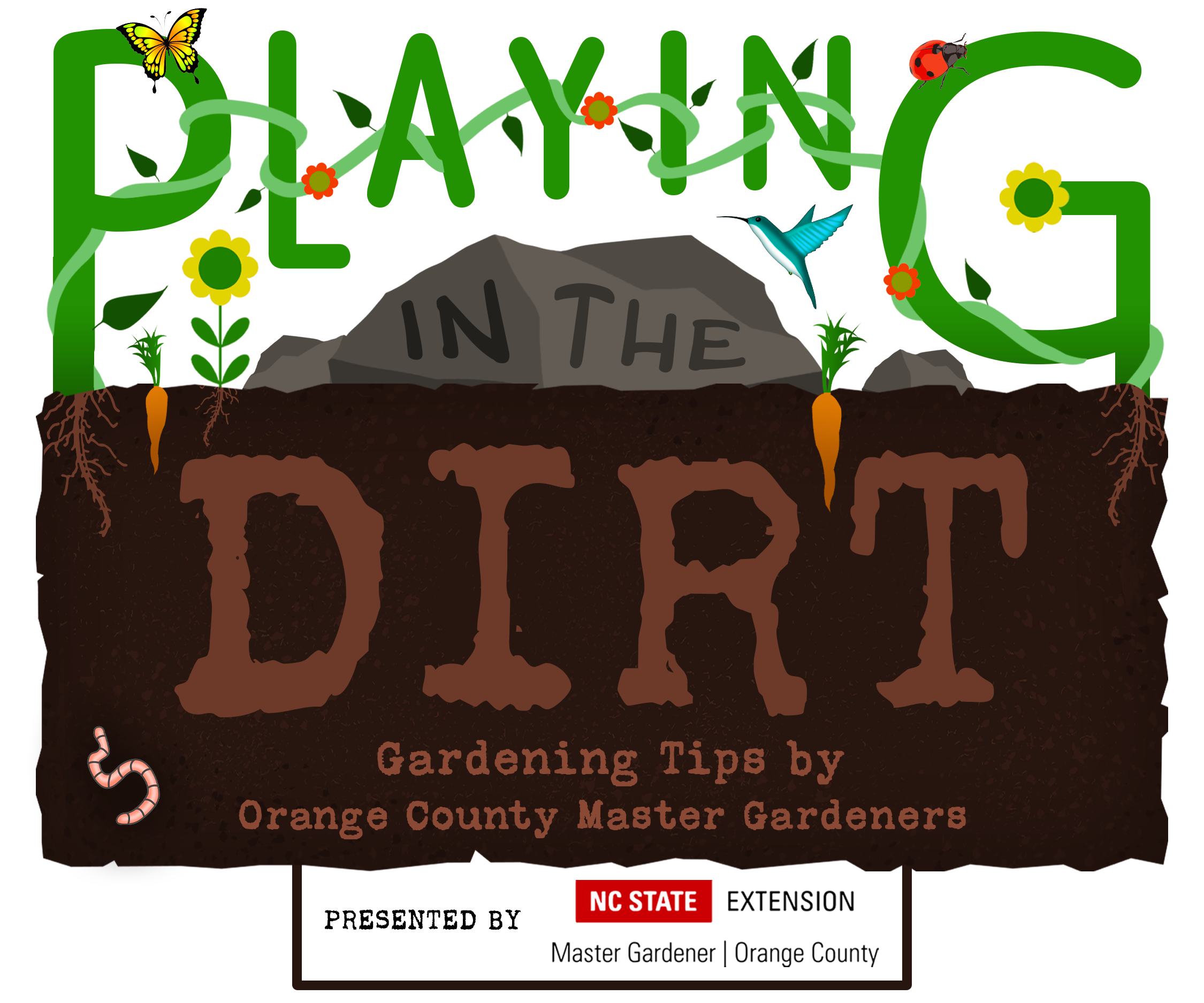
97.9 The Hill and Chapelboro.com have partnered with Orange County Master Gardeners for “Playing in the Dirt,” a monthly column exploring the fertile ground of home gardening in our community and intended to provide the information and inspiration gardeners of all skills levels need to flourish! Check back on Chapelboro each month for a new subject – from our gardens to yours!
By Lorraine Tuck, Orange County Master Gardener Volunteer
If you treat hummingbirds well, they will return.
Each spring I anticipate the return of the hummers. I look forward to hearing the literal buzz in the air and seeing a swoosh, beak first, and then a strong flutter of wings when the first hummer arrives. Once you have one hummingbird, you will have more. That’s a promise.

Hummingbird visiting spring-blooming columbine. Eyesplash, CC BY-NC-ND 2.0.
Our home is on the edge of the woods. We have a high deck with a few dead limbs nearby for perches. I line the deck and dead limbs with red hummingbird feeders which I hang each spring by the time azaleas bloom.
Ruby-throated hummingbirds, the only hummingbird species that breeds in eastern North America, arrive in North Carolina by March or April, hungry after a long flight from Mexico or Central America. They will visit your feeders throughout the spring and summer and into the fall; most leave by mid-October.
Taking good care of hummers means being dedicated to feeding them from mold-free feeders and providing plants that produce natural nectar. You will be rewarded when more return to your yard each year.
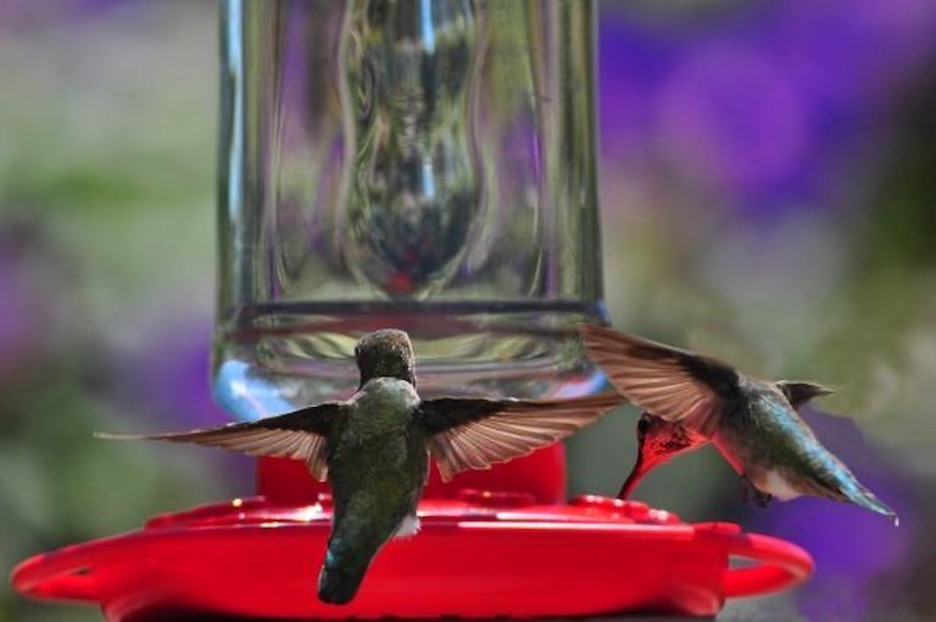
The red parts of a hummingbird feeder attract the birds. Do not add red dye to the sugar water. Bill Gracey, CC BY-NC-ND-2.0.
Feeding Hummingbirds
Start one feeder, using a recipe of 4 parts of water to 1 part of sugar. That means for every 1 cup of water you must have 1/4 cup of sugar; 2 cups of water require 1/2 cup of sugar, etc. Measure the sugar into a large heat-resistant measuring container and then pour boiling water to the top of the sugar. Briskly stir the sugar water until the sugar is dissolved. Then add measured cool water and continue to stir. This way, you don’t have to wait as long for the hummingbird sugar-water mix to cool before pouring it into the feeder.
DO NOT ADD RED DYE! It is unnecessary and does nothing to encourage hummers to your feeders. It’s also easier to keep an eye on the cleanliness of your sugar water if the water is clear.
As the number of hummingbirds feeding around my house increases, I add more feeders. However, I don’t want the sugar water to stay in the feeder more than two or three days. Sugar water can ferment in only a few days, especially during hot summer, causing mold and bacteria to develop. Mold can kill hummers. It is crucial to properly maintain your feeders and keep out mold and bacteria.
Dishwasher-safe feeders may be washed in the dishwasher but they must go through the drying cycle to be sanitized. If you wash by hand, scrub all parts with dish detergent and rinse. To remove dark spots of mold in the feeder, scrub it with a bottle brush or add sand or rice grains and water and shake the feeder. To sanitize a hand-washed feeder, immerse it in a bleach solution of 1 cup of household bleach to 9 cups of water for at least three minutes. Rinse the feeder well and air dry. You can keep and reuse the bleach solution for about three weeks.
Once one feeder is out and you have attracted one hummer, hang a second feeder to attract more birds. Hummers are very territorial and do not like to share feeding spots. If there are two feeders, they will have more space to feed and it won’t take long to have several hummers visiting. There are at least 50 hummers at my six feeders each year.
Important Feeding Times
Hummingbird eggs usually hatch by the end of July. Mother birds need a lot of sugar water to keep up with their hungry babies. At this stage, I keep a gallon of food in the refrigerator to prevent mold and have it ready to refill feeders. With six feeders, I rotate them every two days to prevent mold. I keep four feeders filled (two 2-cup feeders and two 4-cup feeders) while I’m cleaning two.
August also is an important time in the life of a hummingbird; they need to feed often to gain weight for migration. Feeders must be continuously monitored for mold and filled with new sugar water.
You can provide drinking and bathing water for hummingbirds by turning on a sprinkler or hose mist at the same time each day, dripping a small amount of water or filling a small and very shallow rough-surfaced dish such as a clay saucer.
In the fall, I reduce the number of feeders (I only have one feeder up starting in mid-September). One year, I kept a list of dates I thought might be my last view of a hummer at my feeders. The final date was October 15. As long as you keep feeders clean, you may keep them up year-round.
Feeders
I use a brand of feeder with no yellow around the feeder ports. Yellow may attract insects, and that seems to be true in my experience. I get an occasional insect but no infestation of insects other than ants. If ants are a particular problem for you, some feeders have a molded moat inside or at the hook to fill with water to capture ants and other insects. You can also buy moats to attach to feeders. Keep in mind, though, that some insects that might be trapped in the moat are beneficial for your garden.
Although I have been given some beautifully crafted feeders, they do not seem to draw hummers. It may be that the rubber stoppers at the mouth do not allow easy access to the sugar water. I have had the best experience with a feeder made of plastic with a red base and clear cylinder for holding the sugar water. There are similar styles made by several manufacturers that may be found online and in bird specialty stores, hardware stores and garden centers.
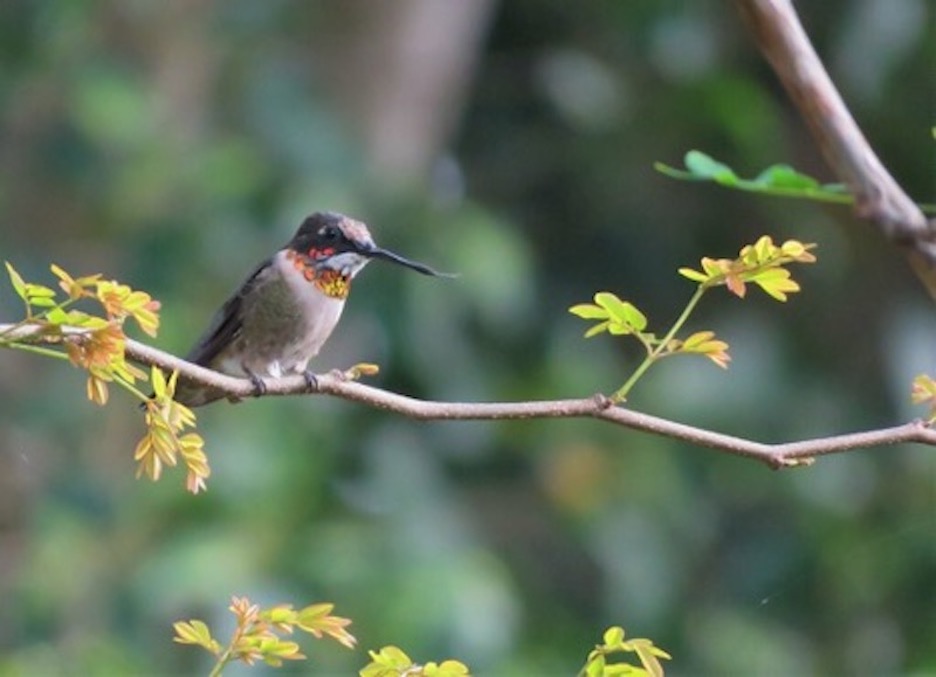
Hummers like to perch on branches of shrubs or trees. Susan Young, Flickr, Public Domain Mark 1.0.
Where to Place Your Feeders
Don’t worry too much about the height of the feeder as hummingbirds are used to hovering low in front of flowers or higher at tree-branch level. The hummers do like to perch on branches of shrubs or trees. Placing the feeder in a shady area will help keep the sugar water fresh longer and may help discourage ants and other insects from feeding. Be sure your feeders are in a spot where you can easily enjoy watching the hummers and keep an eye on the need to fill or clean the feeders.
Plants for Hummingbirds
Natural sources of nectar will attract hummingbirds and other pollinators and will add beauty to your garden. Hummers are especially attracted to plants with red, tubular flowers such as salvia, cannas and other conical reddish plants.
Select a variety of colorful flowers and shrubs with different bloom times throughout the spring, summer and fall to provide a constant natural food source. By placing hummingbird-attracting plants in different areas of your yard, you can help counter their territorial nature when feeding. Also, avoid using chemicals on your flowering plants.
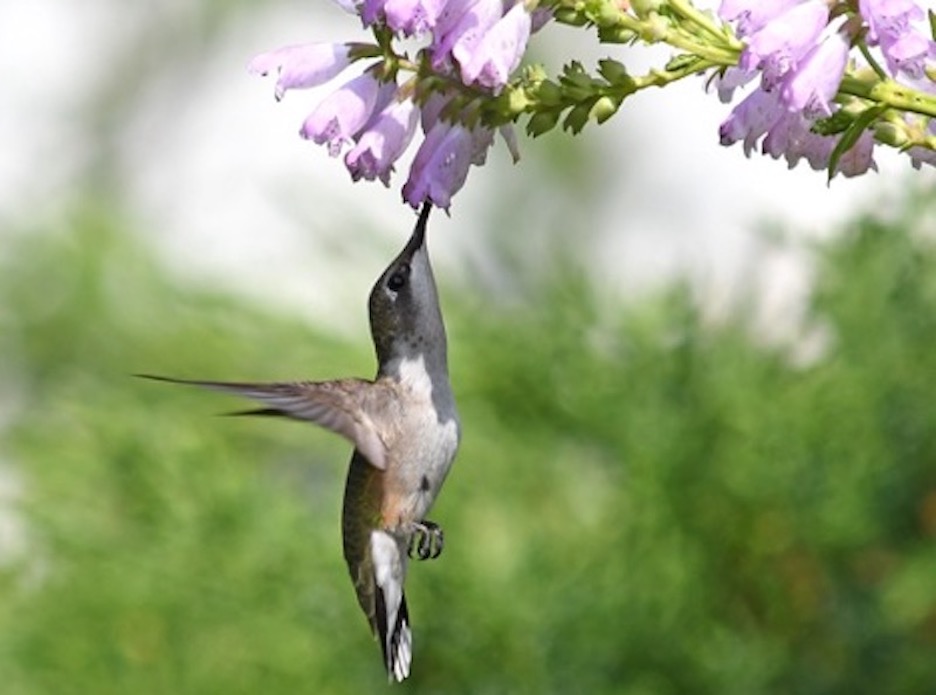
Ruby-throated hummingbird at an obedient plant. U.S. Fish and Wildlife Service – Midwest Region, Public Domain Mark 1.0.
There are a number of flowering plants native to the Southeast that attract hummingbirds, as well as non-native plants.
Flowers that attract hummingbirds and are native to the Southeast include:
- Allium (Allium cernuum, Allium cuthbertii)
- Scarlet sage (Salvia coccinea)
- Cardinal flower (Lobelia cardinalis)
- Columbine (Aquilegia canadensis)
- Bee balm (Monarda didyma) (also called wild bergamot)
- Orange jewelweed (Impatiens capensis)
- Obedient plant (Physostegia virginiana)
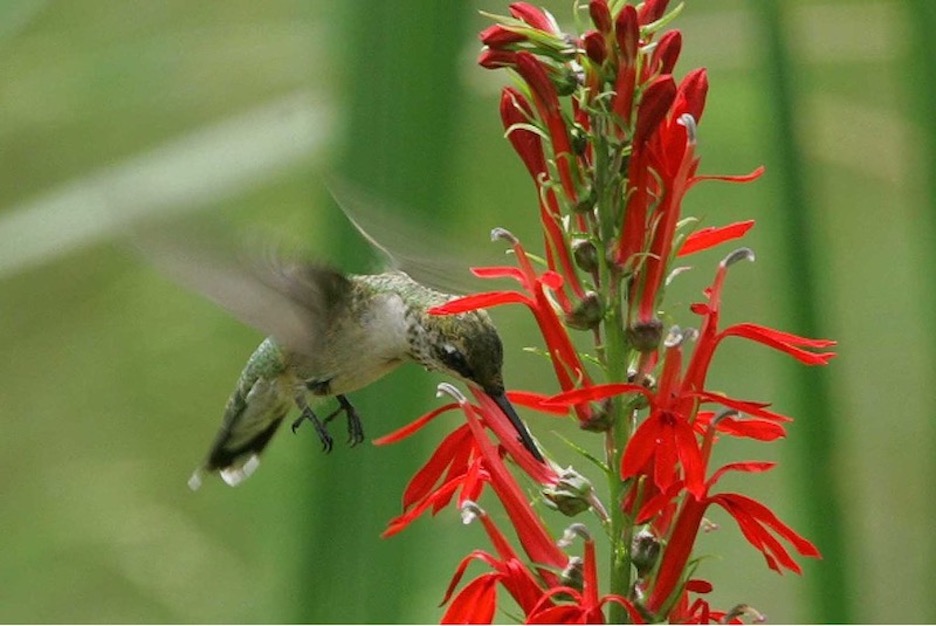
Hummingbird on cardinal flower. U.S. Fish and Wildlife Service – Northeast Region, Public Domain Mark 1.0.
Native flowering vines and shrubs that attract hummingbirds include:
- Trumpet vine (trumpet-creeper) (Campsis radicans)
- Coral honeysuckle (Lonicera sempervirens)
- Native azaleas (Rhododendron species).
Non-native plants that attract hummers include:
- Zinnias (Zinnia)
- Dahlias (Dahlia)
- Lantana (Lantana camera)
- Flowering quince (such as Chaenomeles speciosa),
- Weigela (Weigela florida).
Read More About Attracting Hummingbirds
- Hummingbirds Are Here!, by Rhonda Gaster, North Carolina Cooperative Extension, Lee County.
- The Birds Are Back in Town – Hummingbirds, that is …, NC Wildlife Resources Commission.
- N.C. Museum of Natural Sciences, Information on hummingbirds specific to North Carolina, vagrant hummingbird species and the Museum Banding Project.
- For the Birds, Butterflies & Hummingbirds: Creating Inviting Habitats, Virginia Cooperative Extension. Includes a photographic chart of hummingbird- attracting flowers.
- Cornell Lab of Ornithology. Lots of information about ruby-throated hummingbirds, including identification tips, habitat requirements, sounds/calls, life history and more!
Check us out!
Have a plant or garden question? Email the Orange County Master Gardener Volunteers at ocmgardeners@gmail.com or phone 919-245-2061.
Subscribe to The Garden Buzz, the Orange County Master Gardeners’ monthly newsletter, for local gardening news, events and tips. And visit our website, The Orange Gardener.
Save the date: The Orange County Master Gardener volunteers will hold PlantFest, a plant sale and festival, on Oct. 8, 2022, 9 a.m. to 2 p.m., at the Bonnie B. Davis Environment and Agricultural Center, 1020 US 70 W, Hillsborough, NC 27278.
Chapelboro.com does not charge subscription fees, and you can directly support our efforts in local journalism here. Want more of what you see on Chapelboro? Let us bring free local news and community information to you by signing up for our biweekly newsletter.

